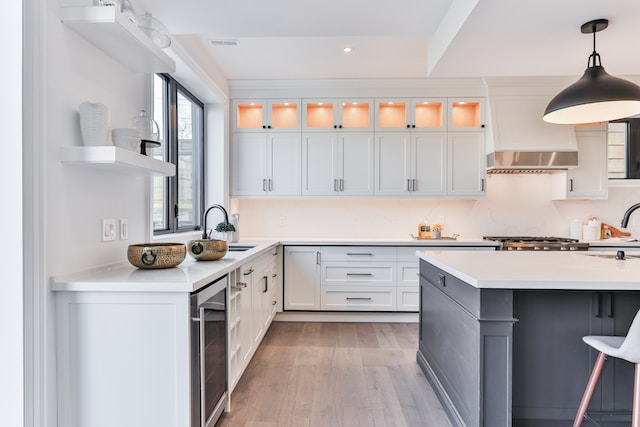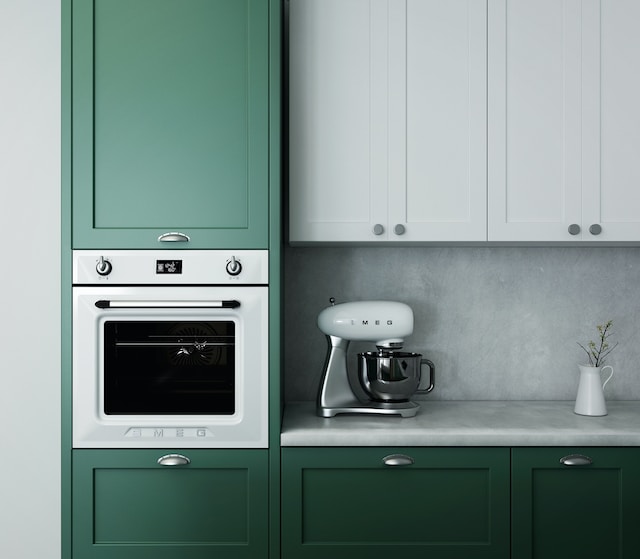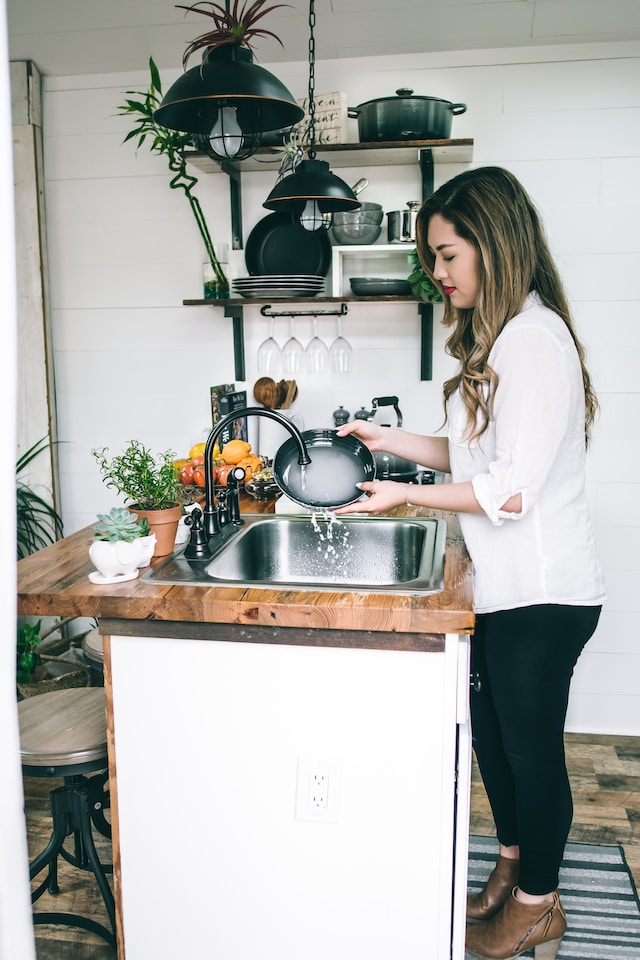
In an age of abundance and excess, there is a growing desire for simplicity and tranquility in our living spaces. Inspired by the minimalist movement that champions the idea of less being more, the concept of a minimalist kitchen and dining area has become a beacon of serenity amidst the chaos of modern life. By decluttering, streamlining, and focusing on essentials, these spaces offer a sanctuary where we can embrace the beauty of simplicity and indulge in moments of mindful nourishment.
Benefits of a Minimalist Kitchen and Dining Area
Creating a minimalist kitchen and dining area yields countless benefits, transcending mere visual or aesthetic appeal. Here, we delve into a few key advantages that underscore the appeal of this design philosophy:
Serenity and Clarity: A minimalist space offers a respite from the chaos and clutter of everyday life. By embracing simplicity and unburdening ourselves from unnecessary possessions, we create an atmosphere of serenity and clarity. Both the mind and the space are cleared, allowing us to focus on the present moment with a heightened sense of calm.
Efficiency and Intentionality: With a minimalist approach, every element in the kitchen and dining area serves a purpose. By eliminating excess items and simplifying storage, we increase efficiency and streamline our daily routines. Ingredients, tools, and utensils become effortlessly accessible, enabling us to cook and dine with intentionality and ease.
Ease of Maintenance: By reducing the number of items in our kitchen and dining area, we simultaneously decrease the effort required to keep them clean and organized. With a minimalist approach, the burden of constant cleaning and tidying is lifted, allowing us to spend more time enjoying the joys of cooking and sharing meals with loved ones.
Mindful Consumption: A minimalist kitchen and dining area prompt us to adopt a more thoughtful approach to consumption. By being discerning about the items we choose to have in this space, we become more conscious of the quality, functionality, and sustainability of our belongings. This mindset extends to our shopping habits, leading to a reduction in food waste and an increased appreciation for the ingredients we use.
Assessing and Decluttering Your Kitchen
As you embark on your minimalist journey, the first step is to assess and declutter your kitchen and get rid of items that do not work with the space . It’s important to approach this process with intention and a discerning eye, keeping in mind the goal of creating a serene and efficient space. Here are some practical tips to guide you through this transformative process:

1. Clear the countertops: Start by removing all items from your countertops. Assess each one and put back only the essentials that you use on a daily basis. This could include a coffee maker, toaster, or a few decorative pieces that bring you joy. The key is to keep the surface clear of unnecessary clutter.
2. Sort through your pantry: Empty your pantry and evaluate each item. Check expiration dates, assess the usefulness of each ingredient, and consider donating any unopened non-perishable items that you no longer need. Organize the remaining items in clear, labeled containers to create a visually appealing and functional space.
3. Simplify your cookware and utensils: Take a critical look at your collection of pots, pans, and utensils. Keep only the ones you use regularly and consider donating or selling the rest. Opt for multi-functional tools that can serve multiple purposes, minimizing the amount of clutter and maximizing the efficiency of your kitchen.
4. Streamline your dishware: Examine your collection of plates, bowls, and glasses. Keep only what you truly need and love, and let go of any mismatched, chipped, or rarely used pieces. Investing in a set of versatile, high-quality dishware will not only declutter your kitchen but also enhance your dining experience.
5. Assess your appliances: Evaluate your appliances and consider their frequency of use. If you find that some appliances are gathering dust and rarely seeing the light of day, it may be time to let them go. Keep only the essentials that align with your cooking and lifestyle habits, and free up valuable counter or storage space.
6. Create efficient storage solutions: Utilize drawer dividers, labeled bins, and vertical organizers to maximize storage space and maintain an organized kitchen. Storing items in a thoughtful and intentional manner will not only make it easier to find what you need, but it will also enhance the overall visual appeal of your minimalist kitchen.
Streamlined Kitchen Layout and Design
Efficiency and functionality are at the core of a minimalist kitchen and dining area. By incorporating a streamlined layout and design, you can enhance the seamless flow and overall aesthetic appeal of your space. Here are some key considerations to keep in mind:
1. Open Concept Design: Consider an open concept layout that connects your kitchen with the dining area, creating a sense of fluidity and togetherness. Removing walls or utilizing glass partitions can help create a visual continuity that promotes the feeling of spaciousness.
2. Clean Lines and Simple Shapes: Embrace clean lines and simple shapes in your kitchen and dining furniture. Opt for sleek and minimalistic cabinets, countertops, and dining tables. This aesthetic choice will create a visually pleasing and uncluttered look while emphasizing the elegance of simplicity.
3. Neutral Color Palette: Choosing a neutral color palette can create a visually calming and cohesive environment. Whites, greys, and earth tones allow the focus to remain on the beauty of the minimalist design. Add pops of color sparingly through accent pieces or art for a touch of personality.
4. Ample Storage Solutions: Maximize storage space by incorporating clever storage solutions into your kitchen design. From deep drawers for pots and pans to pull-out pantry shelves, these innovative storage options will help maintain a clutter-free space while keeping everything organized and easily accessible.
5. Integrated Appliances: Integrating your appliances seamlessly within your kitchen design can enhance the overall look and feel of the space. Opt for built-in or concealed appliances to create a cohesive and uncluttered aesthetic. This also allows for a more streamlined workflow as everything is within reach.
6. Thoughtful Lighting: Pay close attention to lighting in your kitchen and dining area. Opt for soft, warm lighting that creates a relaxing ambiance. Incorporate task lighting under cabinets and inside drawers to ensure functionality while maintaining a visually clean and minimalist appeal.
7. Thoughtful Placement of Accessories and Decor: As a minimalist, choose a few carefully curated accessories or pieces of decor that add personality and charm to your space. Place them strategically to create focal points without overwhelming the overall simplicity of the design.

Selecting a Minimalist Color Palette
In the world of minimalist design, color plays a crucial role in creating a clean and cohesive aesthetic. When choosing a color palette for your minimalist kitchen and dining area, it’s important to embrace simplicity and balance. Here are some tips to help you curate a color scheme that enhances the minimalist appeal of your space:
Choose neutral and muted colors for a clean aesthetic
Neutral colors such as whites, greys, and earth tones are the foundation of a minimalist color palette. These tones serve as a blank canvas, allowing the focus to remain on the simplicity and elegance of the design. Opt for shades of off-white, light grey, or beige for walls and larger surfaces to create a visually calming backdrop. This will also create an illusion of a larger and more open space.
Introduce pops of color sparingly
While a minimalist space typically favors a neutral color palette, that doesn’t mean you can’t incorporate touches of color. However, it’s important to do so sparingly to maintain the clean and uncluttered look. Choose one or two accent colors that truly resonate with you and use them sparingly as statement pieces or pops of color throughout the kitchen and dining area. For example, you could add a vibrant piece of artwork, a strategically placed bowl of fruits, or some vibrant dishware.
Harmonize colors between the kitchen and dining area
To create a harmonious flow between your kitchen and dining area, it’s essential to ensure that the colors complement each other. This doesn’t mean they have to match perfectly, but rather that they should coexist in a way that feels cohesive. Consider using variations of your chosen color palette, such as different shades or tones, to create visual interest and depth while maintaining the minimalist aesthetic.
Creating an Open and Clutter-Free Countertop
A clutter-free countertop is the cornerstone of a minimalist kitchen and dining area. By keeping this space clean and organized, you not only enhance the visual appeal of your kitchen but also streamline your cooking and dining experience. Here are some practical tips to help you create an open and clutter-free countertop:
- Embrace the Less-is-More Approach: Start by removing all unnecessary items from your countertop. Keep only the essentials that you use daily, such as a coffee maker, toaster, or knife block. Consider storing appliances that you use less frequently in cabinets or designated storage areas to free up valuable countertop space.
- Create Zones: Organize your countertop into distinct zones based on their functionalities, such as cooking, food prep, and serving. This helps maintain an efficient workflow and prevents the accumulation of unnecessary items. Designate specific areas for items like cutting boards, mixing bowls, and cooking utensils.

- Clear the Sink Area: Just like the countertop, it’s important to keep the sink area clutter-free. Store dish soap, sponges, and cleaning supplies under the sink or in nearby cabinets. Designate a small bin or tray for wet sponges and brushes to prevent water from accumulating on the countertop.
- Adopt a Minimalist Aesthetic: The visual appeal of your countertop plays a significant role in creating a clutter-free space. Opt for minimalistic and sleek storage containers and utensil holders that match your chosen color palette. Choose one or two statement pieces, such as a stylish fruit bowl or a vase with fresh flowers, to add a touch of elegance without overwhelming the space.
Streamlined Dining Area Design:
Creating a minimalist dining area is all about simplicity, functionality, and creating a space that fosters connections and meaningful moments. Consider these tips when designing your streamlined dining area:
1. Choose the Right Table: Select a dining table that fits the size of your space and the number of people you typically entertain. Opt for a table with clean lines and a minimalist design. A rectangular or circular table tends to work well for a minimalist aesthetic.
2. Seating: Keep your seating minimal and comfortable. Choose chairs or benches with sleek designs that complement the table. You may opt for neutral upholstery to add a touch of warmth and coziness without overwhelming the space.
3. Lighting: Install a statement light fixture above the dining table as a focal point. Opt for a fixture with a minimalist design, such as a sleek pendant or a stylish chandelier. Ensure that the lighting is warm and inviting, creating an intimate ambiance for shared meals.
4. Storage: Incorporate minimalist storage solutions in your dining area to keep clutter at bay. Consider installing floating shelves, a sideboard, or a display cabinet to store tableware, linens, and other dining essentials. Keep the storage design clean and unfussy to maintain the minimalist aesthetic.
5. Art and Decor: Select a few carefully curated pieces of art or decor to add personality to your dining area. Choose pieces that resonate with you and complement the overall minimalist design. Consider incorporating natural elements, such as potted plants or a simple vase with fresh flowers, to bring life and freshness into the space.
6. Consider the Flow: Ensure that the layout of your dining area promotes a smooth flow and encourages conversation. Position the dining table in a central location with enough space around it for easy movement. Remove any unnecessary furniture or objects that may obstruct the flow.
Maintaining a Minimalist Kitchen and Dining Area:
Keeping a minimalist kitchen and dining area organized and clutter-free requires ongoing effort and mindfulness. Here are some tips to help you maintain the serenity and simplicity of your space:

1. Regular Decluttering: Schedule regular decluttering sessions to reassess the items in your kitchen and dining area. Take stock of what you use frequently and what can be let go of. Donate, sell, or recycle any items that are no longer serving a purpose or bringing you joy.
2. Mindful Purchases: Adopt a thoughtful and intentional approach to purchasing new items for your kitchen and dining area. Before acquiring something new, ask yourself if it aligns with your minimalist lifestyle and if it truly adds value to your space. Avoid impulse buys and focus on quality over quantity.
3. Embrace Minimalist Cleaning Habits: Keep up with the cleaning and maintenance of your kitchen and dining area on a regular basis. Adopt simple cleaning routines to prevent the accumulation of dirt and grime. Wipe down surfaces after each use, sweep the floors daily, and deep clean appliances and cabinets periodically.
4. Cook with Intention: Practice mindful cooking by focusing on simplicity and using fresh, high-quality ingredients. Opt for recipes that require minimal preparation and cookware. This not only reduces clutter but also allows you to truly savor the flavors and enjoy the process of cooking.
5. Cultivate Mindful Dining Habits: Approach mealtime as a sacred experience. Set the table with intention, use minimalistic tableware that brings you joy, and savor each bite mindfully. Avoid distractions such as screens or excessive noise, allowing yourself to fully immerse in the joy of sharing a meal with loved ones.
6. Regular Maintenance Check-ins: Set aside time periodically to reassess your kitchen and dining area. Take note of any areas that may be slipping back into clutter or could benefit from further organization. Stay vigilant and make adjustments as needed to maintain the minimalist aesthetic and functionality of your space.
Remember, maintaining a minimalist kitchen and dining area is a continuous process. Embrace the journey and allow yourself to grow and evolve within the principles of simplicity and intentional living. With time and practice, your space will not only become a haven of tranquility but a true reflection of your values and personal style.
